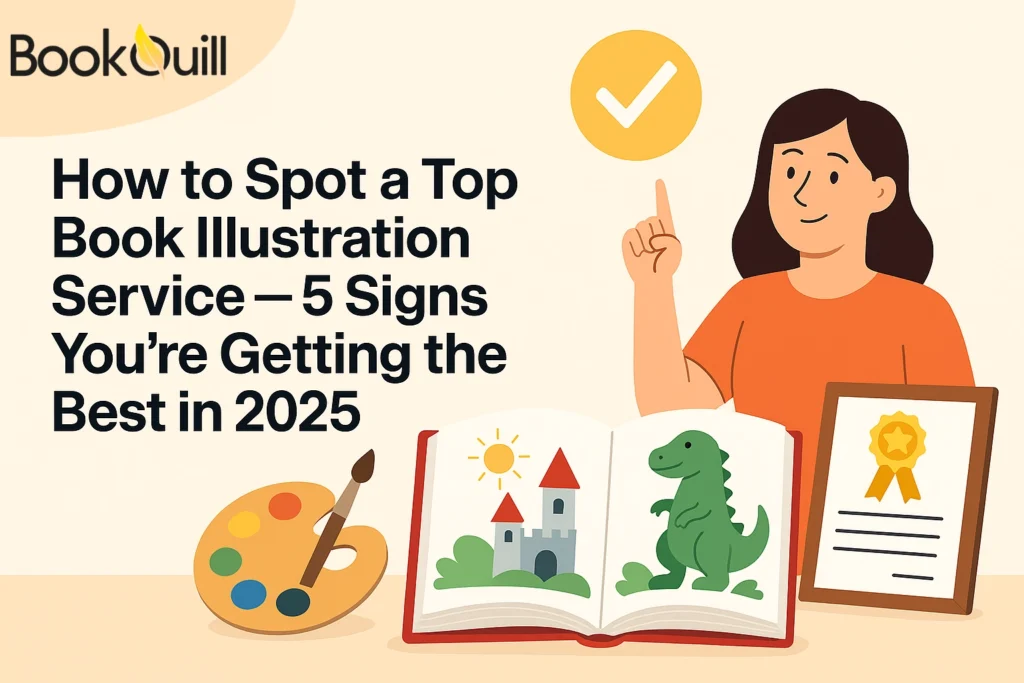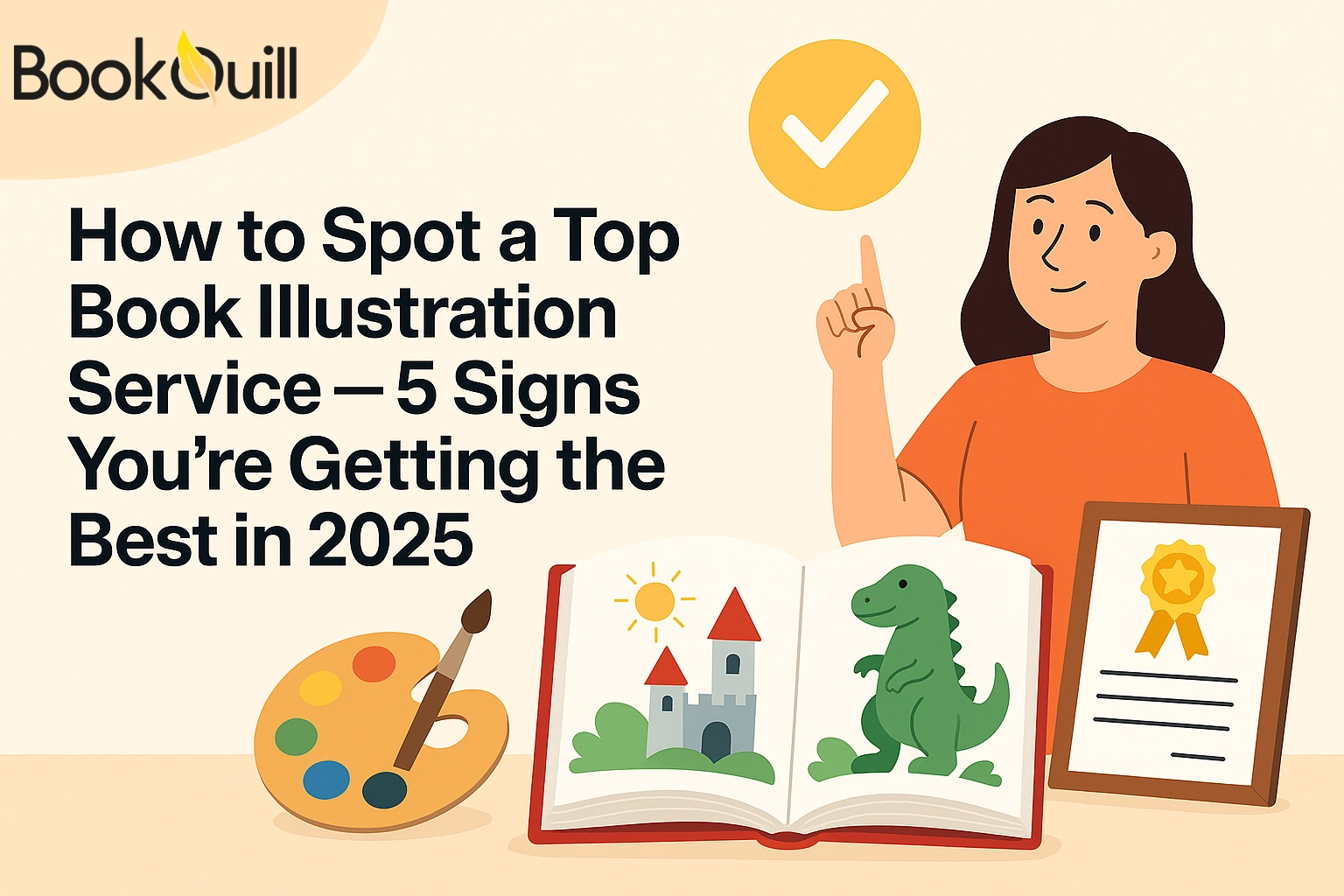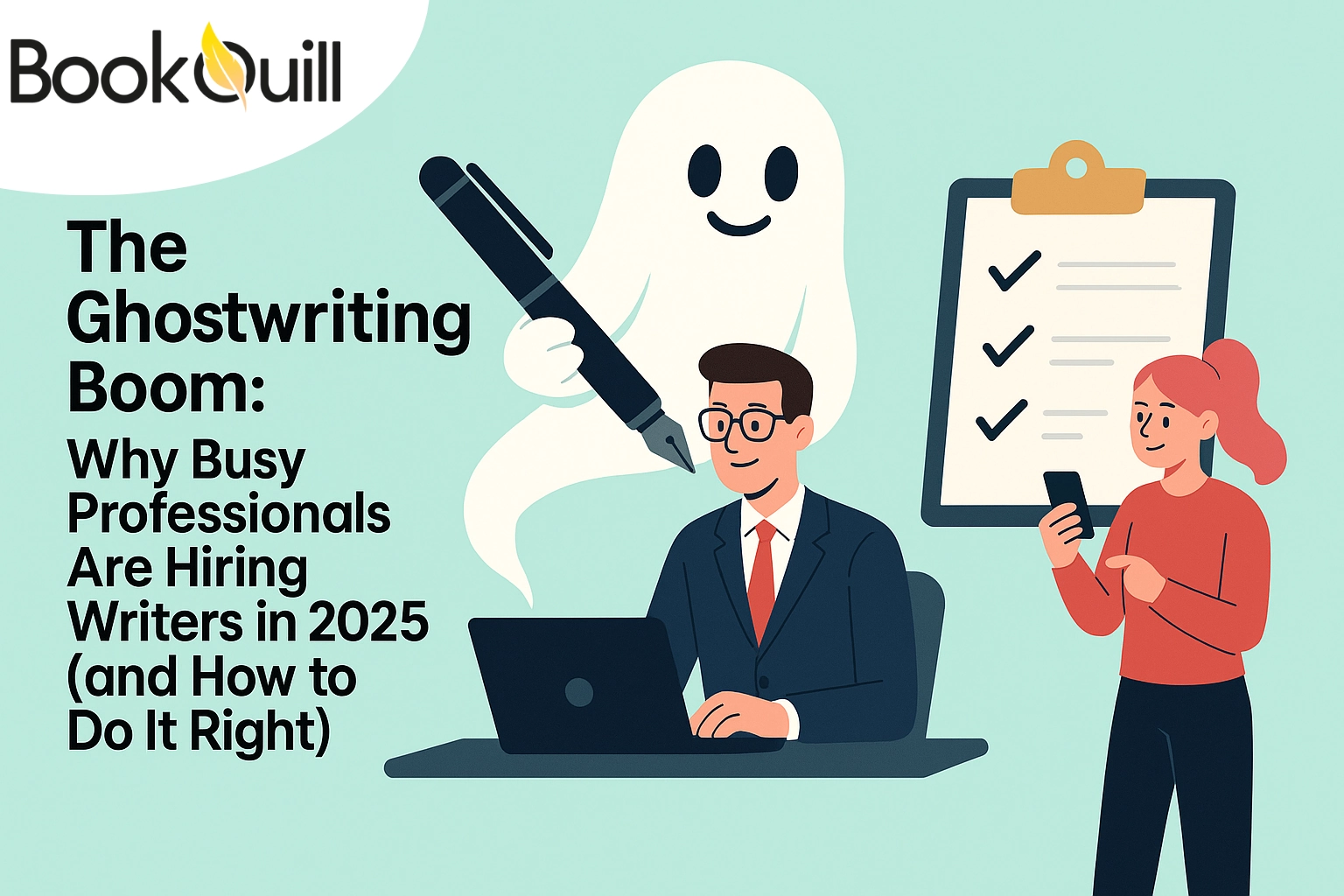Table of Contents
Explore Blogs
Trending on Ebook
How to Spot a Top Book Illustration Service – 5 Signs You’re Getting the Best in 2025

You can tell a lot about a book before reading a single line. Are you wondering how? It is by looking at the illustrations.
Many books, such as Harry Potter, The Annotated Alice, or Breakfast of Champions, and even classic new versions like Dracula or The Odyssey, are remembered because of their art.
There is absolutely no denying that illustrations can turn your ordinary novel into something great. If you are wondering why they are necessary, it is because they:
- Bring characters and settings to life in ways words alone can’t
- Help readers (especially kids) connect emotionally with the story
- Break up long text and keep readers visually engaged
- Support comprehension for visual learners and young readers
- Strengthen your brand and make your book instantly recognizable
- Boost sales potential with shareable, eye-catching visuals
Do you really want to risk your story’s success by skipping the art that could make readers feel every page?
No, right?
Great decision! Now that you’ve made up your mind to get illustrations for your book, it’s time to sort through, identify, and hire the best book illustration services.
The internet is full *cough* “experts” that promise to deliver top book illustrations that are engaging and align perfectly with the content … until the final artwork makes you question if they even read the manuscript.
So, to make sure that you do end up with some amateurs, today we are going to discuss five signs that will help you find and hire experienced illustrators for your book.
Key Takeaways
- Learn why illustrations play a major role in how readers feel and remember a story.
- Find out what makes a genuine illustrator: the one who starts with pencil sketches, not AI shortcuts.
- Skilled artists are those who have the ability to turn written words into visuals that express emotion and meaning.
- See how professional illustrators design art that fits print, digital, and marketing needs without losing quality.
- Understand how style flexibility helps illustrators handle different genres, from children’s tales to fantasy adventures.
- Age psychology and reader empathy are two things that professional book illustrators must understand. It guides the tone and complexity of every illustration.
- Experts always provide adaptable, future-proof illustrations that can support your book’s growth into merchandise or other media.
- Finding a reliable and experienced custom book illustration service is easy. Nope. There are common traps that people fall into.
How to Find an Illustrator: 5 Signs to Work with the Best Ones
1. Artists That Work from Scratch
Here’s the truth: genuine illustrators start with pencil and paper, not AI prompts and plug-ins.
Now that people have tools like Sora and Gemini, many believe that one clever AI prompt can create a masterpiece. But if that’s all it took, why hire “experts” at all? It’s something anyone could do, right?
If your chosen artist starts by sketching on paper with a pencil, you’re in a good spot. Starting with sketches means they are creating your world from the beginning, carefully planning every line, pose, and detail. It shows they know about shape, perspective, and storytelling, not just how things look. This means you are getting real art, not something made by a machine.
If you are wondering, well, AI illustrations are not a problem either. Here are our two cents. Yes, of course, they are not a problem, but they look fake, lifeless, and generic (and people do not like it). However, apart from this, the biggest drawback of AI illustration is copyright issues.
AI-generated images come with a long list of legal and ethical questions. You might not even own the artwork you paid for, and that’s where things get messy.
Here’s why AI illustrations can cause serious copyright trouble:
Unclear ownership: Most AI tools don’t transfer ownership rights. The image might legally belong to the platform or remain in the public domain.
Untraceable data sources: AI models are trained on millions of online images — including copyrighted work from real artists. If your AI-generated image borrows from them, you could be held liable.
No proof of originality: You can’t verify that your illustration is unique, which makes it risky for publishing or merchandising.
Limited commercial rights: Many AI tools restrict the use of the generated art for commercial or resale purposes, which defeats the point if you’re publishing a book.
Future legal uncertainty: As copyright laws evolve, what seems fine today might become a lawsuit tomorrow.
That’s why we keep emphasizing the importance of sketching from scratch. Book illustrators who start with pencil and paper are not only helping you avoid these issues, but it’s also reassuring that you are investing in top book illustrations that are original, creative, and truly align with your book.
2. They Translate Your Words into Pictures
Here’s a truth bomb most people forget: great illustration isn’t about how well someone can draw. It’s about how well they can translate words into feelings.
A top book illustration service understands that every line, color, and shadow tells a story. They’re not just sketching characters. They’re interpreting and presenting the world you have written.
Take children’s books, for example. When you’re trying to find a children’s book illustrator, you’re not just hunting for someone who can draw cute animals.
You’re looking for someone who can show the personality of animals through a smile, fear through a shadow, and curiosity through an eye tilt.
Now, for example, as an author, if you say: “The little girl finally faces the storm she’s been running from.”
Bad illustrator: draws a smiling girl holding an umbrella under a cartoon rain cloud.
Good illustrator: shows the girl standing barefoot on muddy ground, wind blowing her hair, her tiny hand reaching out toward the lightning. This shows that she is scared but determined.
That’s the difference between drawing and storytelling.
So, when you’re deciding how to find an illustrator for a book, look for one who asks deep questions.
Do they want to understand your character’s journey?
Do they ask about your audience’s age group or mood?
If yes, you’ve probably found a keeper.
Many excellent creative platforms help authors find book illustrator or a designer for their cover vision. Some of them are:
- 99designs, where you can explore multiple art styles and fresh perspectives.
- Behance, a space to study professional portfolios and artistic diversity.
- Dribbble, great for inspiration and design trends.
- Fiverr Pro, where you can connect with verified professionals for smaller projects.
3. They Integrate Market and Print Knowledge into Their Art
Here’s where real professionals separate from freelancers. A top book illustration service knows that good art must also be marketable and technically print-ready.
That means they:
- Design within bleed and trim margins
- Use CMYK color profiles for print (not RGB)
- Plan illustration placement to leave space for text and spine alignment
- Understand Amazon KDP and IngramSpark specs
- Deliver layered source files for repurposing covers, ads, and merch
Example:
Many first-time authors lose hundreds fixing art that bleeds off margins or clashes with text layout. Top services anticipate those issues from day one.
Ask your illustrator if they collaborate with typesetters or formatters. If they do, you are working with someone who understands the whole publishing world, not just the creative part.
4. They Can Switch Styles Without Losing Quality
A top book illustration service acts like an actor. They can shift personalities without losing authenticity.
Every genre asks for a different visual rhythm.
For instance:
- Children’s books need warmth, roundness, and expressive color.
- Fiction often calls for cinematic realism, like lighting, contrast, and movement.
- Nonfiction benefits from clarity and visual focus.
- Fantasy thrives on detail, scale, and mood.
A professional illustrator can move between these tones without losing quality or consistency. That kind of versatility separates experienced artists from beginners. Skilled book illustrators can design whimsical picture books, gritty detective covers, historical romance scenes, and faith-based guides – basically everything. They make sure that each one of them is visually distinct and never recycled.
Good illustrations should look great in any format, whether in printed books or on screens. Custom book illustration services that offer different file types and colors adjusted for each medium make sure the artwork looks good for print, Kindle, and eBook formats.
5. They Master Age Psychology and Reader Empathy
A top book illustration team doesn’t just guess what readers like. They understand what people at different ages see, feel, and process. That’s what makes their work connect on a deeper level.
This goes far beyond style. It’s about cognitive design. It is about how visual choices affect understanding and emotion.
For children, every detail has purpose:
- Ages 3–5 respond best to bold shapes, simple forms, and high-contrast colors. Repetition helps them follow the story visually.
- Ages 6–8 engage with expressive faces, lively movement, and storytelling backgrounds that give emotional cues.
- Ages 9–12 prefer layered scenes with hidden details, visual puzzles, and evolving color palettes that keep them exploring.
For teens and adults, illustrations speak to psychology in a different way. Mature readers look for mood, symbolism, and subtext. They want images that reflect tone and theme.
Young adults connect through dynamic poses, cinematic lighting, and emotion-driven compositions.
Adults respond more to atmosphere, realism, and color psychology that mirrors genre: muted palettes for drama, high contrast for thrillers, soft tones for romance.
When book illustrators understand these details, the outcome isn’t just attractive and appealing. It becomes an important part of the story, helping to shape feelings, timing, and what readers remember.
BONUS: They Future-Proof Your Illustrations for Adaptation
Surprise Surprise!!!
Bonus sign alert and an important one, so read carefully.
This is the secret no one talks about. In 2025, your book is not just a book. It’s a brand asset that later down the road might evolve into audiobooks, merch, or even an animation pitch.
If your book illustrator designs every illustration with adaptability in mind, you’ve found the right one. That means they’re thinking beyond the printed page. This means that every illustration you will get from experts will easily fit:
- Promotional materials
- Social media posts
- Ebooks
- Future adaptations or spin-offs
- Merchandise
This also means that your chosen illustrator knows that modern storytelling (especially the one with illustration) does not stop at the book itself. It extends to branding and marketing, and for that, they need illustrations that work and connect with the audience.
Common Traps When Hiring an Illustration Service (and How to Avoid Them)
Trap #1 – A Fancy Portfolio That Isn’t Theirs
Some agencies showcase work that looks too good to be true because it is. Many use stock art or borrowed images. For example, you open an illustrator’s website. Every single character has the same nose, the same eyes, and the same facial expression. One looks like a pirate, one like a schoolteacher, but if you look closely, you will realize that somehow they could be twins.
That’s not versatility.
That’s a template!
And if you want a top book illustration service, you want variety and not a clone factory.
For credibility, always check credentials:
- Do they list author names or ISBNs?
- Do styles look consistent across samples?
- Can they explain their creative process?
Professional book illustrators can. And they’ll happily show before-and-after drafts to prove authenticity.
Trap #2 – Vague or Unusable Rights
Ownership confusion is one of the biggest legal pitfalls for authors. Many writers assume that once they’ve paid for an illustration, it automatically belongs to them. Unfortunately, that’s not always true. Some book illustrators or agencies keep partial ownership or limit how the art can be used, which can block you from reusing those visuals for sequels, merchandise, or even marketing campaigns.
Trap #3 – Hidden Costs and Surprise Fees
A clear quote should include:
- Revisions
- Backgrounds
- Source files
- Print setup
If a quote feels too cheap, there’s probably a catch. Transparent pricing is the sign of an experienced professional.
Conclusion
“Can a picture really say what words cannot?” When it comes to books, the answer is always yes.
Finding the right illustrator is not just about getting pretty images. It is about finding someone who understands your story, your readers, and your vision. A top book illustration service knows how to turn your ideas into visuals that carry emotion, clarity, and meaning.
Always remember that the best illustrators care about both creativity and quality. They ask smart questions, stay clear about rights, and make sure your book looks as powerful as it reads.
Before you hire anyone, take a moment to think. Are they creating real art or quick digital shortcuts? Are they helping your story come alive or just merely decorating the pages?
Choose the illustrator who listens, collaborates, and creates from the heart. Because in the end, a great story deserves great art — and your readers deserve to see the world you imagined.
FAQs
1. How long does a full book illustration project take?
The timeline depends on the book’s length and complexity. A children’s picture book might take 8 to 12 weeks, while a detailed novel cover series could take several months. The process usually includes concept sketches, feedback rounds, coloring, and final formatting.
2. What should I provide to my illustrator before they start working?
Always share your manuscript, a brief summary of your story, descriptions of key characters, and any visual references you have in mind. Providing mood boards or sample images also helps the illustrator understand your tone and expectations clearly.
3. Do illustrators help with book covers or only the inside illustrations?
Many illustrators do both. In fact, a unified art style between your cover and interior pages creates stronger branding.
4. Is it okay to hire more than one illustrator for the same book?
It can be, but it’s risky. Mixing styles might break visual consistency and confuse readers. If your project requires multiple artists (for example, a collection of stories), make sure there’s a shared style guide or color palette to keep everything cohesive.
5. What file formats should I ask for from my illustrator?
Request high-resolution formats such as TIFF or PNG for printing, along with layered PSD or AI files for editing and resizing later. Always ask for CMYK versions for print and RGB for digital publishing to avoid color issues.
Should I give credit to my illustrator in the book?
Yes, always. Crediting your illustrator not only shows respect for their work but also builds credibility for your project. A simple “Illustrations by [Name]” on the cover or title page is usually enough.
Note: Some of the links in this post are affiliate links. This means if you click on them and make a purchase, we may earn a small commission at no extra cost to you. We only recommend products and services we genuinely trust and believe will be useful to our readers. Your support means a lot. Thank you!
About Author
Hi, my name is Zachary Stone I’m a book marketing nut — or, as I like to call myself, a “Shelf Marketer.” No, I don’t sell wooden shelves; I market the books that are left forgotten on them. If you want your book to be the next bestseller, I am your go-to person. I am here to remind you that it’s not just about writing a great story — it’s about building a buzz among people with great campaigns.






